What Color Eggs Do Black Australorps Lay
Black Copper Maran chickens are an incredibly beautiful breed. With their rich copper and jet black coloration, they're a real showstopper in any family flock.
In addition to their exquisite appearance, the Black Copper Maran is a dual-purpose chicken…
Contents
This means they are used for both egg production and meat.
So, if you're after a chicken that is both striking and versatile, you can't go wrong with a feather legged Black Copper Maran…
Chapter I
Introduction

This breed is one of my favorite breeds to own – I'll admit, a lot of that is because of their gorgeous coloration.
However, their decent egg production (the eggs are also a rich deep brown!) and flavorful personalities make them a firm staple in my flock.
As someone who's owned their fair share of Black Copper Marans over the years, I'll be sharing my helpful tips and tricks on keeping this lovely breed, including feeding, coop setup, brooding, and health concerns.
Let's start with where they came from…
History of Marans
Black Copper Marans originate from South Western France in an area around La Rochelle.
Locally, these chickens were known as "swamp chickens" as they are native to low and marshy habitats.
The original Black Copper chickens were crossed with local barnyard hens and gamecocks that were brought over from Indonesia and India.
These birds were known as Marandaise fowl.
Origin

The Standard Black Copper Maran available today is the resulting offspring of many breeds of chicken, including the Brahmas, Gatinais, Coucou de Rennes, Croad Langshan, and Coucou de Malines.
Black Copper Marans rose in popularity in France initially due to their sought after deep chocolate eggs.
However, during post war France, Black Copper chickens brinked on extincion.
Repopulation
This encouraged the Department of Agriculture in France to create a breeding program for
Black Copper Marans, in addition to increasing the breed's egg production.
Breeding Program
The program was a huge hit, and by 1952, Black Copper Marans were laying around 200 eggs per year.
Since the breeding program ended around this time, many chicken breeders have improved the breed standards of the Black Copper Maran.
Additionally, while still considered rare in the United States, they are no longer as rare as they once were.
What Are Black Copper Marans Known For?
Black Copper Marans are known for their chocolate colored eggs.
Marans in general have dark eggs, but Black copper chickens have especially dark brown eggs.
Are Black Copper Marans Dual Purpose?
The Black Copper Maran is a dual-purpose chicken, so they can be raised for both egg production and meat.
This breed produces between 150 dark brown eggs to 200 eggs each year, and can grow to a decent size.
How Long Do Copper Marans French Chickens Live?
The Standard Black Copper Maran chicken usually lives for around 8 years, but they can live longer with good care.
Give this breed plenty of space, a nutritious diet, and a clean habitat to ensure they live healthily and happily.
Breed Standards of Marans

Breed standards for Black Copper Marans differ for each country. The bird is classified as a large fowl and 'Continental' breed.
In France and the United States, both clean legged and lightly feathered legs are recognized.
However, in the United Kingdom only clean legged Black Copper Marans are recognized.
Features
The Black Copper Chicken has a red single comb and face, as well as red earlobes and wattles.
They have a slightly hooked beak that is horn (off-white) colored, and orange eyes.
This breed has slate or pink colored feet and shanks, but their skin and the soles of their feet are white.
Black Copper Identifications
- Black Copper Marans should have a red plumage with no mahogany or yellow shades.
- Roosters should be black breasted red with a small amount of spotting on their chest.
- Roosters should also have a black triangle on their wings, red shoulders, and copper colored feathers on their neck, hackles, and back (known as "lancets").
- Hens, on the other hand, should be black with red hackle markings. Minimal red breast markings are also recognized.
Flaws associated with the Black Copper Maran breed standards include "off" coloration, yellow shanks, white earlobes, overly feathered legged, and black eyes.
Both males and females can have lightly feathered legs or be completely clean legged.
Recognition
Did you know that French Black Copper Marans were only recognized by the American Poultry Association in the United States in 2011? Clean Legged Marans were recognized by the Poultry Club of Great Britain in 1935.
In the latter, feather legged Marans or specimens with lightly feathered legs are not recognized.
FUN FACT
Getting a breed recognized by the American Poultry Association is hard work, and up until 2011, the Standard Revision Committee felt the Marans they were shown had imperfections such as brown eyes instead of reddish-bay.
Chapter II
Appearance

Now that we know about the history of the breed
Let's move onto identifying them properly.
A quick rundown on how they look like and their unique features…
What Do Black Copper Maran Chickens Look Like?

If you look at a Black Copper Maran from its side, you will see that it has a V-shaped body.
This breed has a strong and long build with wide shoulders – sadly, these attributes are why Black Copper Maran roosters are commonly used in cockfighting.
- All Marans have striking plumages, but particularly Standard Black Coppers.
- The body feathers are jet black and shine an iridescent green in sunlight.
- The hackle feathers in males and females are a deep red color, but Black Copper Marans roosters have copper colored saddle feathers that sweep over their backs.
- Most specimens are clean legged (this means they don't have any feathers on their legs), but some may have lightly feathered legs.
NOTE
While Black Copper Maran roosters are more stunning than females, the hens are still very striking birds.
Maran Chicken Colors
Maran chickens come in a huge range of colors, all of which are vibrant and radiant birds. Not all of these varieties are recognized by the APA, including the Splash and Silver Cuckoo.
Here are some of the lovely color varieties the Maran bird comes in:
- White
- Silver Cuckoo
- Golden Cuckoo
- Salmon
- Birchen
- Black Copper
- Black-Tailed Buff
- Wheaten
- Blue Copper
- Splash
- White Copper
- Blue Wheaten
- Columbian
- Brown Red
Sexing Marans French Black Copper Chickens
The majority of chicken breeds produce monomorphic chicks.
This means that both males and females look identical after they have hatched.
Black Copper Marans chicks are monomorphic, unfortunately, so they're difficult to sex until a few months old.
By around 8 weeks old, male Marans chicks will begin to show dark red feathering on their wings and shoulders.
In comparison, females will only get this coloration on their chest area and neck.
Appearance of Marans
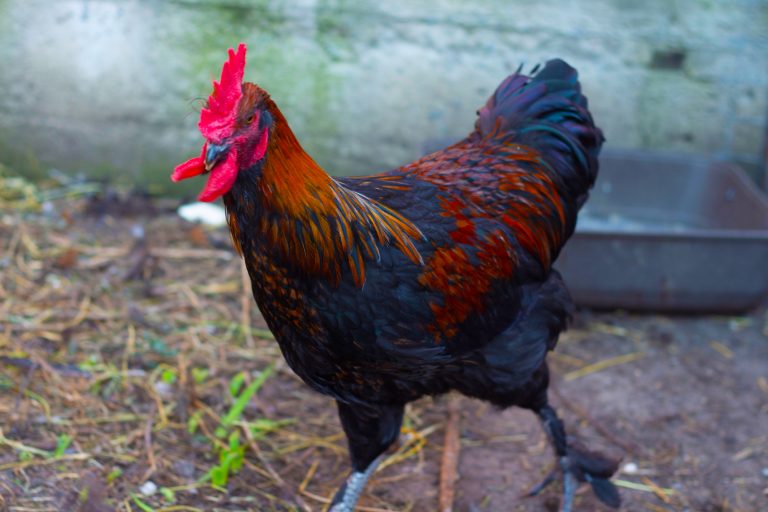
As I mentioned earlier, French Black Copper Marans have a long and strong body that forms a "V" shape when viewed from the side.
This breed is well-known for its phenomenal plumage: body feathers are black with green iridescence, whereas hackle feathers are a rich coppery brown color.
Legs
Most Black Copper Marans are clean legged, but some specimens may have a small amount of feathers on their legs.
The Black Copper Marans rooster has reddish-brown saddle feathers that cascade over their back.
Even though hens lack this quality, they are still just as attractive.
Skin Color of the Black Copper Maran
Both a Black Copper Marans rooster and hen has white skin. Their shank, however, is either a slate or pink color.
How Big Do Marans French Black Copper Marans Chickens Get?
French Black Copper Marans are a fairly large breed, with females usually reaching around 6.5 pounds in weight.
Roosters are slightly larger at about 7 to 8 pounds.
Bantam variants of Marans exist but they are very seldom seen due to their rarity.
Chapter III
Egg Laying and Production

Now that we know what they look like.
What can a Black Copper Maran provide to your coop?
Want to know how many eggs the Black Copper Maran lays?
Don't go anywhere – here's all you need to know about Marans eggs…
Are Black Copper Marans Good Layers?
In terms of quantity, Black Copper Marans are average egg layers. They produce around 150 to 200 eggs per year, which is similar to most other breeds.
However, the quality that sets this breed's eggs from other chickens is their color.
The Black Copper Maran produces a dark brown egg – it looks just like chocolate (unfortunately, it doesn't taste like chocolate too – still delicious though!).
All Marans lay deep brown eggs, but the Black Copper Marans egg is highly sought after by French chefs as it is especially dark.
FUN FACT
Contrary to popular belief, these darkest eggs don't taste any different than regular eggs. They just look striking.
Brooding
Standard Black Copper Marans don't go broody very often, but they are good sitters when they do.
Hens are attentive towards their chocolate brown eggs and take great care of their chicks once they have hatched.
Age of Egg Laying in Marans
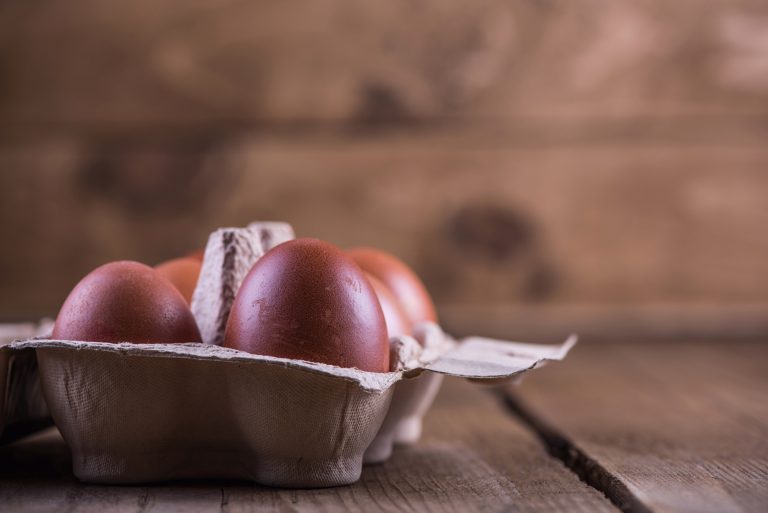
Black Copper Marans normally start laying at around 5 to 6 months of age but it can sometimes take even longer (I've even heard up to 8 or 9 months!).
Your hen's diet, genetics, environment, and the time of year will influence her age of laying.
My Black Copper Maran hen was around 6.5 months old when she first started laying dark eggs.
How Many Dark Eggs Do Marans Lay Per Year?
Most Black Copper Maran hens lay between 150 and 200 chocolate brown eggs, which is considered standard.
How Many Dark Eggs Do Marans Produce Per Week?
Black Copper Maran hens typically lay between 2 to 3 dark brown eggs each week.
What's the Standard Egg Size for a Black Copper Marans Chicken?
Marans eggs are usually standard to large in size.
Personally, my hen lays pretty large eggs on a consistent basis. When she first started laying, her eggs were a tad smaller in size.
Black Copper Marans Chicken Egg Color – Dark Chocolate Brown, Light Brown, or White Eggs?
As I mentioned earlier, Black Copper hens lay dark eggs.
However, if your hen lays less eggs than standard, her eggs will be a darker chocolate egg color.
In comparison, hens who lay more eggs than standard will have lighter eggs.
Some eggs can also have darker colored spots.
See what Black Copper Marans eggs look like in this video below…
Egg Laying
Egg laying of this breed can be cyclical – this means that your hen will lay dark eggs at the beginning of the laying season (Spring is normally the peak season for the highest number of eggs laid) gradually becoming lighter by the end.
Egg Color
Additionally, the color of your Marans hen's egg is hereditary – if the mother hen lays extremely dark eggs, the female chicks will too.
Alternatively, if the mother hen lays light brown eggs, so will the female offspring.
Black Copper Marans will lay the darkest eggs of their lifetime in their first year.
FUN FACT
Did you know that the chocolate brown color you see on this breed's eggs can be wiped off? If you attempt to wash the egg and get a little carried away with scrubbing, the color will come off.
That's because the egg color is on the shell – it's a mucous-esque coating that dries rapidly after your hen has laid the egg.
Are Black Copper Marans Good for Meat?
As Black Copper Maran chickens are a dual-purpose breed, they are good birds to raise for meat.
Standard hens weigh roughly 6 pounds and males normally weigh between 7 and 8 pounds.
Coop and Run Setup – How Much Space Do Marans Need?
Black Copper Marans can get to a rather large size once mature, so you'll want to make sure they have a big enough coop and run to inhabit.
Ideally, give each bird at least 2 to 3 square feet of space inside a coop.
Runs should provide each chicken with a minimum of 8 to 10 square feet of space.
Bigger is always better, so try to give your Marans the biggest run and coop you can.
Free Roam
While Black Copper Marans can tolerate confinement, they thrive when kept free range.
This breed loves to forage and roam, so make sure they get plenty of time and space to do just that!
Chickens that are kept in severely cramped conditions can become aggressive or develop behavioral problems such as feather picking.
Chapter IV
Feeding

If you didn't already know, chickens are omnivores.
This means they consume both plant matter and meat-based foods.
Although Black Copper Marans will forage during free range (my hen loves hunting for earthworms!), you'll still need to feed them a well-balanced diet to make sure they get everything they need.
What should you feed them to keep them healthy?
Commercial Feed for Marans & Black Copper Marans Rooster
Black Marans should be given a good-quality commercial poultry feed every day in order to thrive.
This should make up the bulk of your bird's diet.
You can get poultry feed in mash, crumbed, or pellet form.
Types
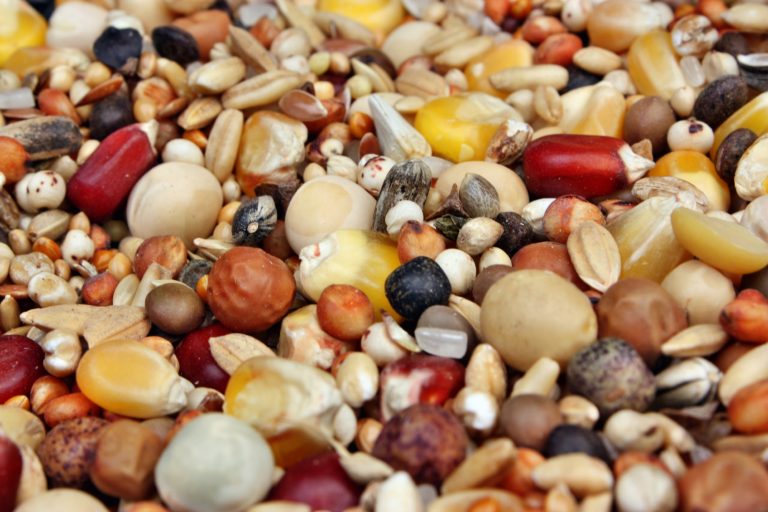
Each one has its own benefits and drawbacks – crumbed and mash feeds are easier for chicks, pullets, and small breeds to eat.
Unfortunately, it produces a lot of mess which could attract vermin and pests.
- Pellet feeds produce very little waste but are best used for adult chickens. Younger birds may find pellets a bit harder to consume.
- Standard poultry feeds contain grains (such as corn, soybeans, and oats), grit, and vitamins (calcium).
NOTE
If you feathered friends don't get the right diet, they're more at risk of a weakened immune system, becoming egg bound, developing nutrient deficiencies, and more.
Fruits/Vegetables and Food Scraps
As well as a good-quality chicken feed, Marans should get a range of fresh fruits and vegetables each day.
Most fruits and vegetables are suitable for Marans, but make sure you check their safety first (more on this below).
From personal experience, I've found Marans enjoy spinach, silverbeet, berries, banana, apple, and broccoli.
All Marans have different likes and dislikes, so feed your bird a variety of fruits and veggies to see what they like the most!
Food To Avoid
Food scraps like cooked rice, cooked pasta, and bread are also favorites in my flock.
Avoid raw potatoes, uncooked beans, uncooked rice, avocado, chocolate, avocado, citrus fruits, apricot, garlic, and foods high in fat or sat.
Additionally, if you see any spoiled food in your refrigerator, throw it out – don't feed it to your Marans.
If you're not certain whether a food is safe for chickens, err on the side of caution or consult a poultry veterinarian/expert before feeding it to your Marans.
NOTE
Depending on your Marans' age, size, and sex, dietray requirements will differ. If you see thin or soft Marans eggs in your coop, your hens may be deficient in calcium.
Grit
Marans need a good amount of grit in their diet to keep them fit, well, and healthy.
Grit helps these birds digest their food, so it's important that Marans have access to gravel, ground limestone, or ground oyster/cockle shell.
Every hen and rooster needs grit in their diet to keep them well and healthy.
This is necessary to help them digest their food, so you'll want to ensure you give your flock plenty of it.
TIP
If your Marans don't have an outdoor space with grass or dirt, it's particularly vital you provide them with grit such as one of the options I mentioned above.
Poisonous Plants
When free ranging, chickens can get into things they're not supposed to from time to time. That's why you should make sure your Marans can't access any plants or weeds that could be toxic to them.
Some plants that are poisonous to Marans include:
- Daffodil
- Morning Glory
- Lily of the Valley
- Tulips
- Foxglove
- Azaleas
- Jimson Weed
- Iris
- Bracken Fern
TIP
If you see any plants that you're not sure are safe for chickens, it's a good idea to remove them anyway to be on the safe side.
Water
Like all chickens, the clean legged Marans breed requires fresh and clean water each day. You should refill your bird's water container at least once daily.
During cold weather, make sure your bird's water doesn't freeze over – chickens won't be able to drink ice! I like to use a heated water container during chilly months so I don't run into this issue.
Chapter V
Temperament

Black Copper Marans are laidback and gentle birds, at least towards humans.
Both hens and roosters are active – they like foraging and exploring, so allowing this breed to free range is optimal.
While relatively docile, Black Copper Marans aren't one of the most affectionate chicken breeds…
My hen will only tolerate petting for a very short period of time and doesn't enjoy being picked up.
NOTE
Personality will differ slightly for each individual – some birds may be very friendly, others not so much. As a rule though, Black Copper Marans aren't a cuddly breed of chicken.
Are Black Copper Marans Friendly?
With Other Chickens
Black Copper Marans normally get on well with most other chickens. However, males can be a bit aggressive or confrontational with other males.
As Black Copper Maran roosters are commonly used in gamecock fighting, this isn't surprising.
NOTE
Although the majority of Black Copper Maran roosters don't exactly get along with other breeds of rooster, there are always exceptions to the rule.
With People

As I mentioned earlier, these clean legged birds are normally gentle and easy-going towards humans.
Marans aren't overly affectionate or loving birds, but they certainly aren't unfriendly.
TIP
If you handle your Black Coppers from a young age (ideally when they are chicks), it will help them become friendlier.
Are Black Copper Maran Chickens Noisy?
Black Copper Marans aren't a quiet breed of chicken as they do produce a fair amount of noise – nothing out of the ordinary for a large fowl breed though.
Male Marans are a lot louder than hens, so that's something to take into consideration if you have neighbors.
RECOMMENDATION
If you want to get a relatively quiet breed of chicken, I'd recommend breeds like the Cochin, Brahmas, Australorps, and Ameraucana.
Chapter VIII
Health
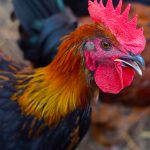
Black Coppers, like any other chicken breed, can become sick from time to time – that's why you'll want to know a little more about common health concerns that can affect these clean-legged birds.
Here's what to look out for and things to do to keep them healthy…
Health Issues
As always, if you have any concerns regarding the health of your Marans breed, get them checked out at a veterinarian as soon as possible.
Some common health issues of marans are lice, mites, bumblefoot, intestinal parasites, vent gleet, vent prolapse, and egg binding.
A Large Clean Coop Is Essential
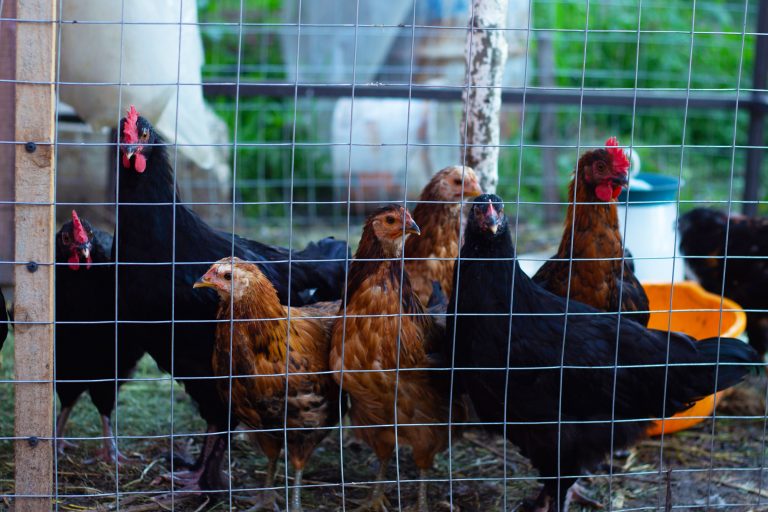
A clean environment is optimal for chickens to keep them healthy and happy. Additionally, keeping your Marans' coop clean will help prevent many illnesses.
So, how do you keep your birds' coop clean?
Daily Cleaning
Every night, remove any uneaten food from your coop and refill their water container.
Tidy away any droppings and dirty nesting material each day (replace it with clean bedding, ideally one that is dry but insulating like straw).
Lastly, give your coop a good deep clean a few times a year.
That's all there is to it, and hey presto! You now have yourself one happy and healthy flock.
NOTE
Keeping your coop clean and hygienic is important no matter what breed of chicken you own. Not only will your chickens thrive in a tidy habitat, but it will help prevent a lot of illnesses.
Special Considerations of Marans
Climate
Marans normally do quite well in both hot and cold climates, but their egg production can drop a little during chilly weather.
However, as Marans chickens have a single comb, they are prone to developing frostbite. If you see the weather turning dark and cold, provide your bird with plenty of dry nesting material (straw is a good option) and keep their coop well ventilated.
Even in colder months, your coop should offer plenty of ventilation to prevent moisture from building up.
TIP
You should position your roosting perches wide apart and remove any wet bedding. When preventing frostbite in chickens, keeping moisture to a minimum inside your coop is crucial.
Signs of Frostbite in Chickens
You your Marans have frostbitten combs, feet, or wattles, they will normally have symptoms like
- Color change of tissues (pale, greyish-blue, whitening, lightening, or grayish-yellow)
- Poor appetite
- Listlessness
- Limping
- Blackened tissues
- Swelling
- Tissues that are cold or hard to touch
- Blisters – you may see that they are filled with a clear or milky liquid
Should I Get Black Copper Marans Chickens?
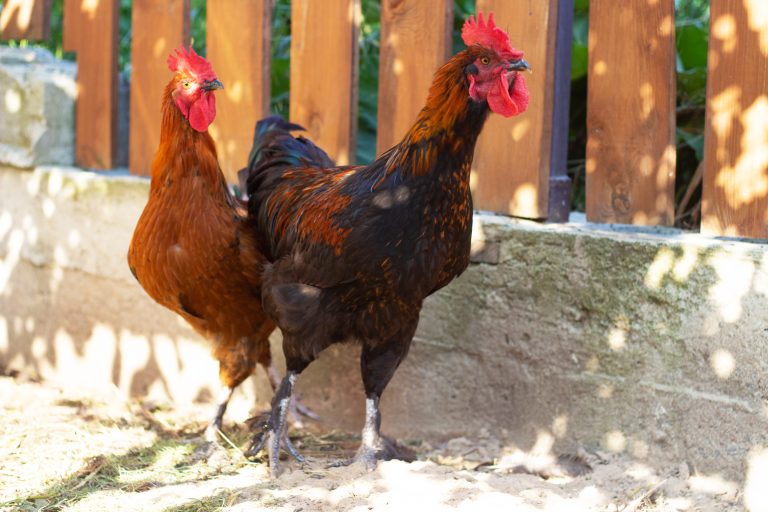
If you're after a striking clean legged chicken with beautifully colored feathers, you can't go wrong with Marans. Black Copper Marans, Golden Cuckoo Marans, Silver Cuckoo Marans, White Marans – all Marans are known for their gorgeous feathers.
Black Copper Marans in particular are very appealing, even the hens
Dual Purpose
In addition to their pretty appearance, Black Coppers are a dual-purpose breed – not only do they lay a decent number of eggs each year (150 to 200), but they also make good meat birds.
So, a bird that looks pretty and provides you with plenty of eggs and meat – what's the catch? Unfortunately, this breed is considered quite rare in the United States, so you may have some trouble finding one.
If you do manage to find a Black Copper Maran hatchery or breeder, then they're an excellent bird to raise and own.
Final Thoughts
Black Copper Marans are a remarkable breed of chicken, not just because of their radiant black and copper feathers, but also due to their versatility.
Although not the most affectionate breed, they are a relatively docile and laidback bird.
My Black Copper Maran hen is one of my favorite chickens in my flock due to her calm and energetic nature.
Her vibrant colors also make her stand out among some of my more standard colored hens.
If you can track down a breeder or hatchery that sells Black Coppers, I fully recommend raising these birds.
Finding Black Marans
Finding a hatchery that sells Marans does require a bit of research as you'll want to ensure the place takes great care of their livestock.
I'd advise scouring poultry forums to find the best hatchery in your local area. Look up reviews and the quality of the chicks once you've found a hatchery you want to buy from. This will help you ensure the chicks you bring home are in the best health.
Don't just go with the first feather legged hatchery you find.
Share Your Thoughts!
I hope I helped you learn a bit more about Black Copper Marans, but let me know if there's anything I missed that you're uncertain of.
What do you think of Black Copper Marans? Are they your favorite Maran?
Be sure to let me know on our social media platforms
Personally, I really like White Copper and Golden Cuckoo Marans!
If you're after more helpful tips and tricks on chickens, then take a look at our other informative guides.
What Color Eggs Do Black Australorps Lay
Source: https://www.chickensandyou.com/black-copper-marans/